Assessment of the condition of the fetus during pregnancy and childbirth
 Methods for assessing the condition of the fetus 1. Assessment of the features of the anatomical development of the fetus. 2. Study of its functional state. Clinical, biochemical and biophysical research methods are used to assess the condition of the fetus during pregnancy and childbirth.
Methods for assessing the condition of the fetus 1. Assessment of the features of the anatomical development of the fetus. 2. Study of its functional state. Clinical, biochemical and biophysical research methods are used to assess the condition of the fetus during pregnancy and childbirth.
 Clinical methods auscultation determination of the frequency of fetal movements determination of the growth rate of the uterus determination of the nature of the staining of the amniotic fluid (with amnioscopy, amniocentesis, amniotic fluid rupture)
Clinical methods auscultation determination of the frequency of fetal movements determination of the growth rate of the uterus determination of the nature of the staining of the amniotic fluid (with amnioscopy, amniocentesis, amniotic fluid rupture)
 Amnioscopy n Examination of the lower pole of the ovum (membranes, amniotic fluid, and presenting part of the fetus) using an amnioscope.
Amnioscopy n Examination of the lower pole of the ovum (membranes, amniotic fluid, and presenting part of the fetus) using an amnioscope.
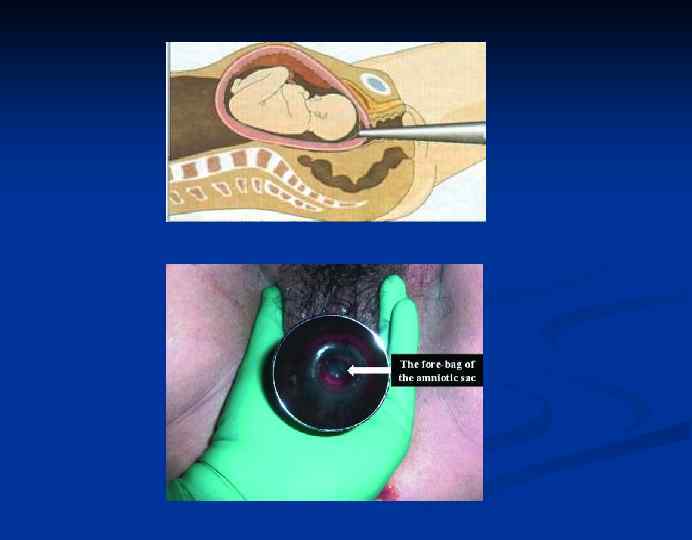
 n n Normal color of amniotic fluid - transparent or straw yellow Pathological coloration: Green - stained with meconium, a sign of fetal hypoxia Bright yellow (golden) - Rh conflict Red - premature placental abruption Brown (dark brown) - intrauterine fetal death
n n Normal color of amniotic fluid - transparent or straw yellow Pathological coloration: Green - stained with meconium, a sign of fetal hypoxia Bright yellow (golden) - Rh conflict Red - premature placental abruption Brown (dark brown) - intrauterine fetal death
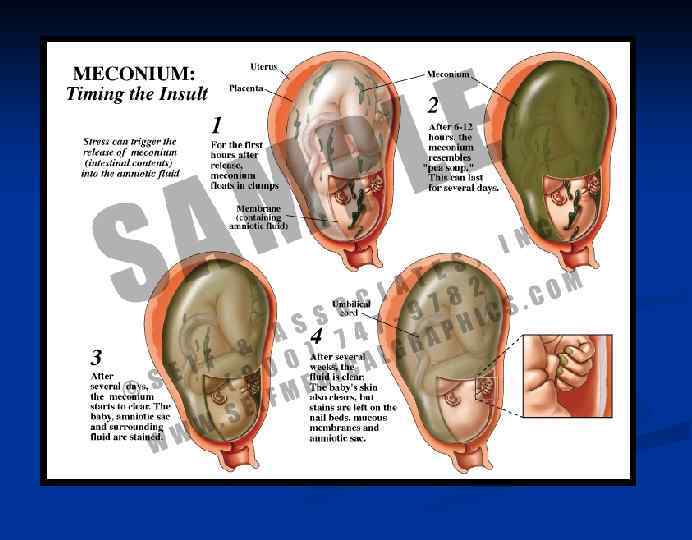
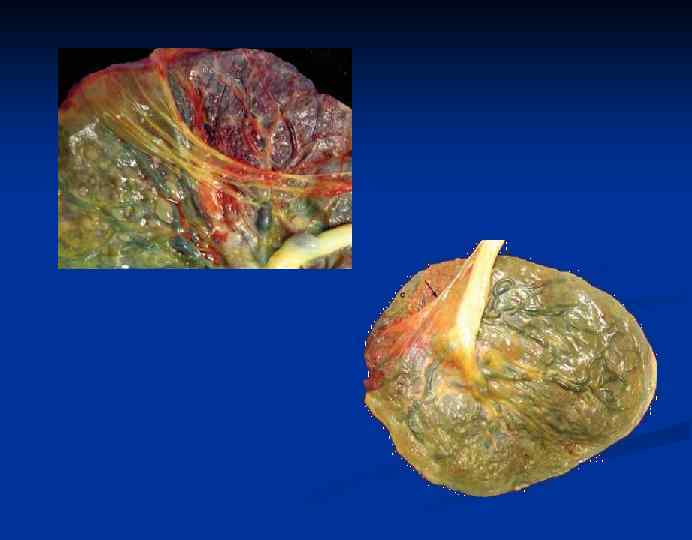
 Amniocentesis Puncture of the amniotic membrane in order to obtain amniotic fluid for subsequent laboratory research, or the introduction of drugs into the amniotic cavity.
Amniocentesis Puncture of the amniotic membrane in order to obtain amniotic fluid for subsequent laboratory research, or the introduction of drugs into the amniotic cavity.
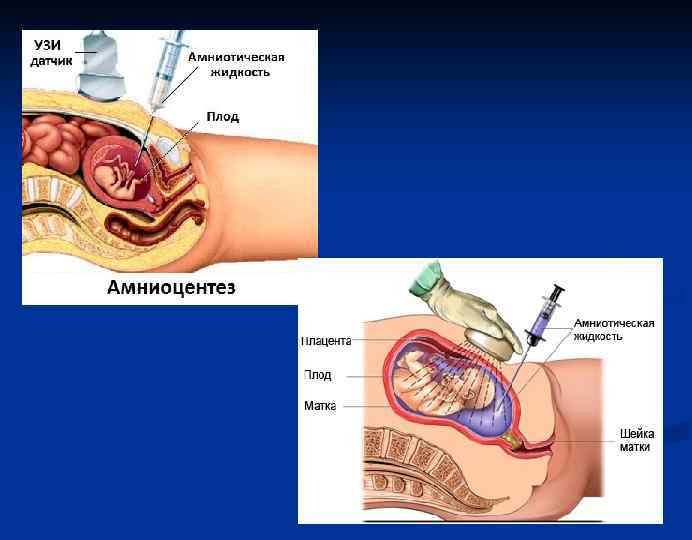
 Biochemical methods for the study of the hormonal profile: chorionic gonadotropin, placental lactogen, estrogens (estriol), progesterone, prolactin, thyroid hormones, corticosteroids; determination of the degree of fetal maturity on the basis of a cytological study of amniotic fluid and the concentration of phospholipids (lycetin and sphingomyelin) in amniotic fluid obtained by amniocentesis; examination of fetal blood obtained by intrauterine puncture - cordocentesis; chorionic villus sampling for fetal karyotyping and determination of chromosomal and gene abnormalities.
Biochemical methods for the study of the hormonal profile: chorionic gonadotropin, placental lactogen, estrogens (estriol), progesterone, prolactin, thyroid hormones, corticosteroids; determination of the degree of fetal maturity on the basis of a cytological study of amniotic fluid and the concentration of phospholipids (lycetin and sphingomyelin) in amniotic fluid obtained by amniocentesis; examination of fetal blood obtained by intrauterine puncture - cordocentesis; chorionic villus sampling for fetal karyotyping and determination of chromosomal and gene abnormalities.

 Electrocardiography determines the heart rate, the nature of the rhythm, the size, shape and duration of the ventricular complex. Phonocardiography is represented by oscillations reflecting I and II heart sounds.
Electrocardiography determines the heart rate, the nature of the rhythm, the size, shape and duration of the ventricular complex. Phonocardiography is represented by oscillations reflecting I and II heart sounds.
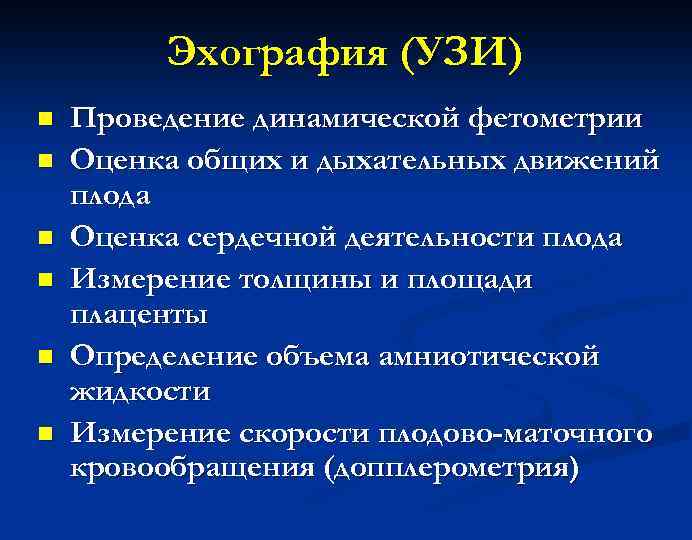 Echography (ultrasound) n n n Dynamic fetometry Assessment of general and respiratory movements of the fetus Assessment of fetal cardiac activity Measurement of the thickness and area of the placenta Determination of the volume of amniotic fluid Measurement of the fetal-uterine circulation (Doppler)
Echography (ultrasound) n n n Dynamic fetometry Assessment of general and respiratory movements of the fetus Assessment of fetal cardiac activity Measurement of the thickness and area of the placenta Determination of the volume of amniotic fluid Measurement of the fetal-uterine circulation (Doppler)
 Cardiotocography (CTG) continuous synchronous recording of the fetal heart rate (HR) and uterine tone with a graphic representation of the signals on the calibration tape.
Cardiotocography (CTG) continuous synchronous recording of the fetal heart rate (HR) and uterine tone with a graphic representation of the signals on the calibration tape.
 The heart rate is recorded by an ultrasonic sensor based on the Doppler effect. Registration of the tone of the uterus is carried out by strain gauges.
The heart rate is recorded by an ultrasonic sensor based on the Doppler effect. Registration of the tone of the uterus is carried out by strain gauges.
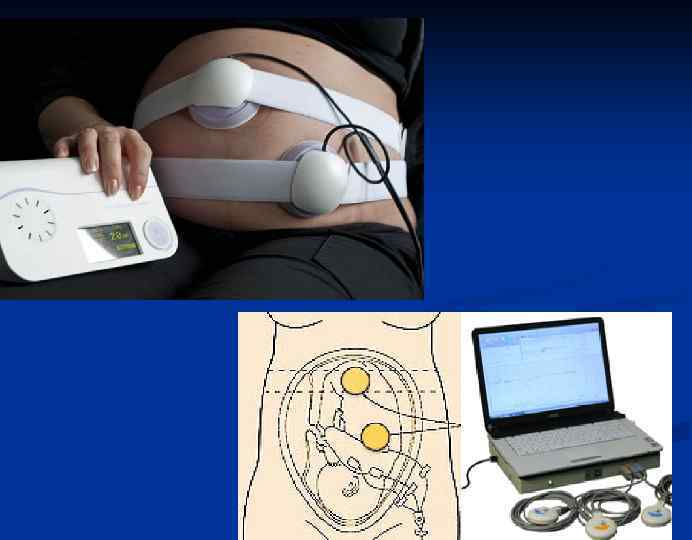
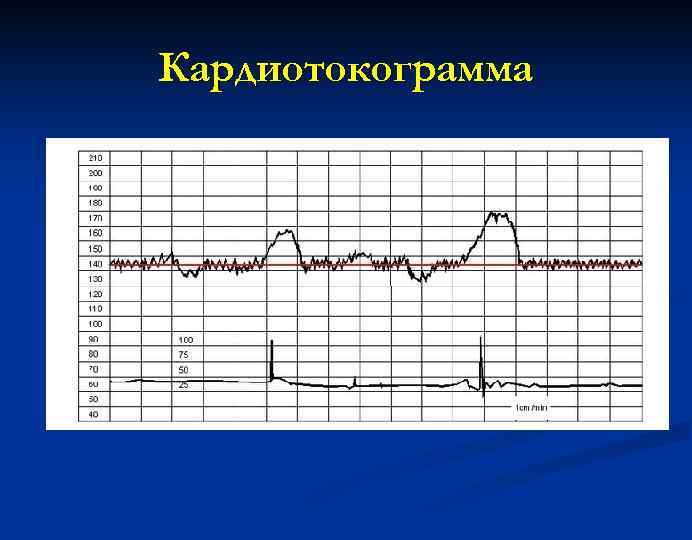
 CTG parameters n n n basal heart rate variability of the basal rhythm: frequency and amplitude of oscillations amplitude and duration of accelerations and decelerations fetal heart rate in response to contractions of fetal movement functional tests
CTG parameters n n n basal heart rate variability of the basal rhythm: frequency and amplitude of oscillations amplitude and duration of accelerations and decelerations fetal heart rate in response to contractions of fetal movement functional tests
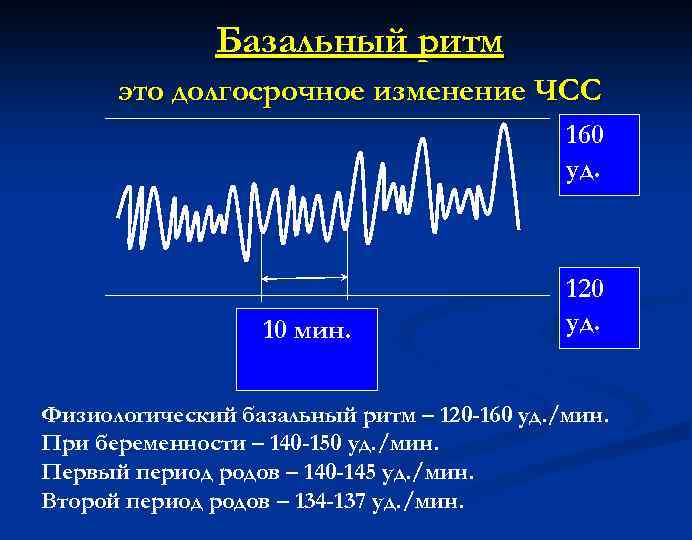 Basal rhythm is a long-term change in heart rate of 160 beats. 10 min. 120 beats Physiological basal rhythm - 120 -160 beats. / min. During pregnancy - 140 -150 beats. / min. The first stage of labor is 140 -145 beats. / min. The second stage of labor is 134-137 beats. / min.
Basal rhythm is a long-term change in heart rate of 160 beats. 10 min. 120 beats Physiological basal rhythm - 120 -160 beats. / min. During pregnancy - 140 -150 beats. / min. The first stage of labor is 140 -145 beats. / min. The second stage of labor is 134-137 beats. / min.
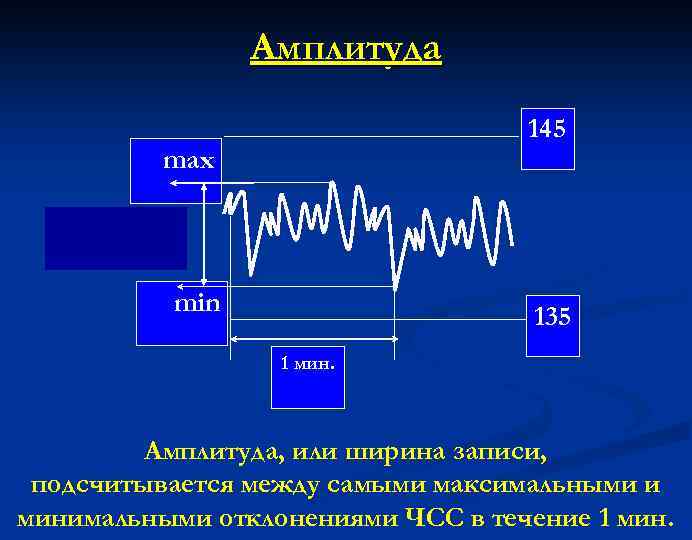 Amplitude 145 max min 135 1 min. The amplitude, or recording width, is calculated between the highest and lowest heart rate deviations for 1 minute.
Amplitude 145 max min 135 1 min. The amplitude, or recording width, is calculated between the highest and lowest heart rate deviations for 1 minute.
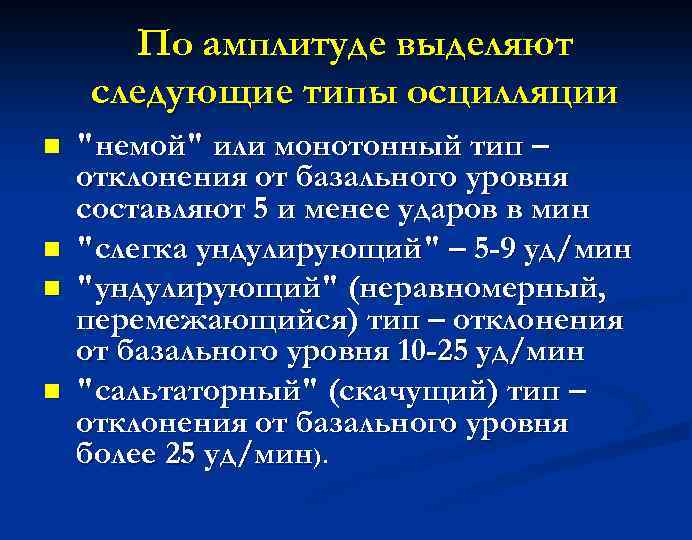 In terms of amplitude, the following types of oscillations are distinguished nn "mute" or monotonic type - deviations from the basal level are 5 or less beats per minute "slightly undulating" - 5 -9 beats / min "undulating" (uneven, intermittent) type - deviations from the basal level 10 -25 beats / min "saltatory" (jumping) type - deviations from the basal level more than 25 beats / min).
In terms of amplitude, the following types of oscillations are distinguished nn "mute" or monotonic type - deviations from the basal level are 5 or less beats per minute "slightly undulating" - 5 -9 beats / min "undulating" (uneven, intermittent) type - deviations from the basal level 10 -25 beats / min "saltatory" (jumping) type - deviations from the basal level more than 25 beats / min).
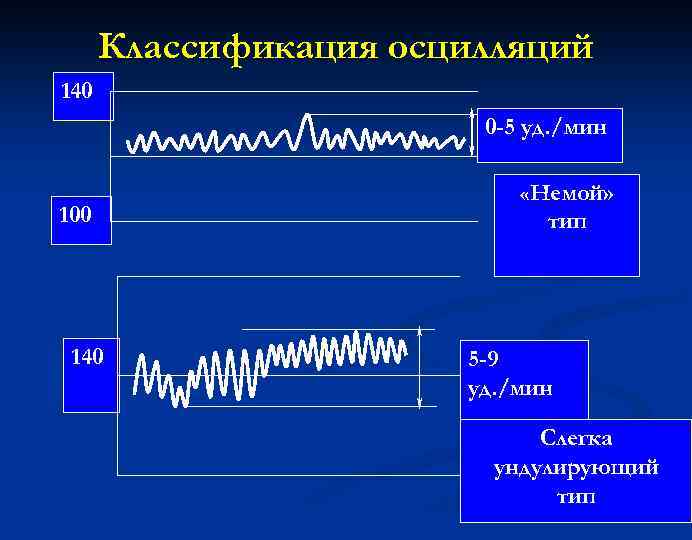 Oscillation classification 140 0 -5 beats / min 100 140 "Mute" type 5 -9 beats. / min Slightly undulating type
Oscillation classification 140 0 -5 beats / min 100 140 "Mute" type 5 -9 beats. / min Slightly undulating type
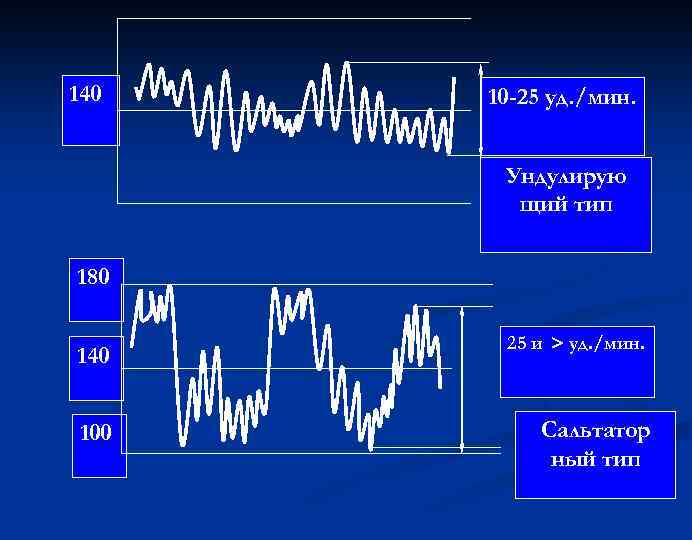 140 10 -25 beats / min. Undulating type 180 140 100 25 and beats / min. Saltatory type
140 10 -25 beats / min. Undulating type 180 140 100 25 and beats / min. Saltatory type
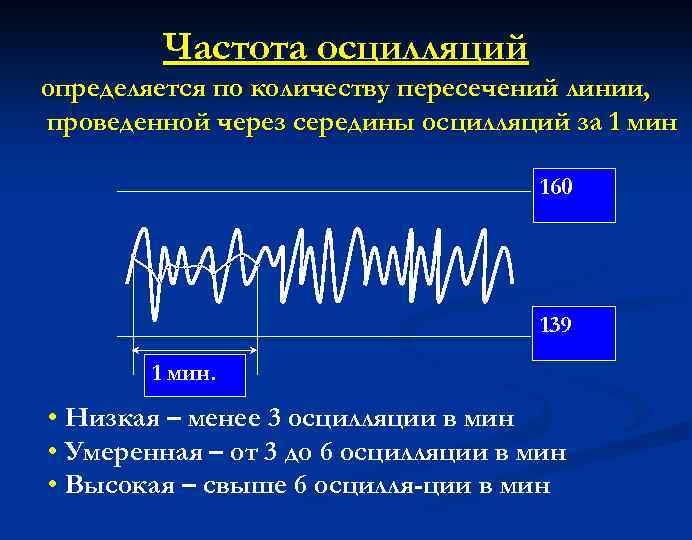 The frequency of the oscillations is determined by the number of crossings of the line drawn through the midpoints of the oscillations in 1 min 160 139 1 min. Low - less than 3 oscillations per minute Moderate - from 3 to 6 oscillations per minute High - more than 6 oscillations per minute
The frequency of the oscillations is determined by the number of crossings of the line drawn through the midpoints of the oscillations in 1 min 160 139 1 min. Low - less than 3 oscillations per minute Moderate - from 3 to 6 oscillations per minute High - more than 6 oscillations per minute
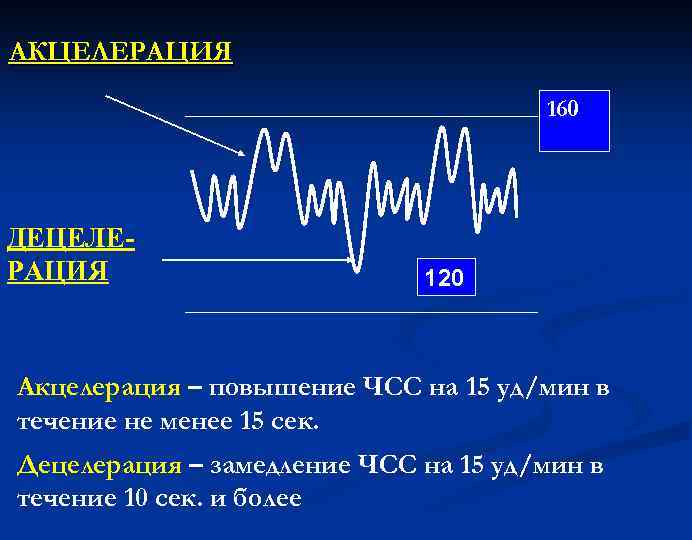 ACCELERATION 160 DECELERATION 120 Acceleration - increase in heart rate by 15 beats / min for at least 15 seconds. Deceleration - slowing down the heart rate by 15 beats / min for 10 seconds. and more
ACCELERATION 160 DECELERATION 120 Acceleration - increase in heart rate by 15 beats / min for at least 15 seconds. Deceleration - slowing down the heart rate by 15 beats / min for 10 seconds. and more
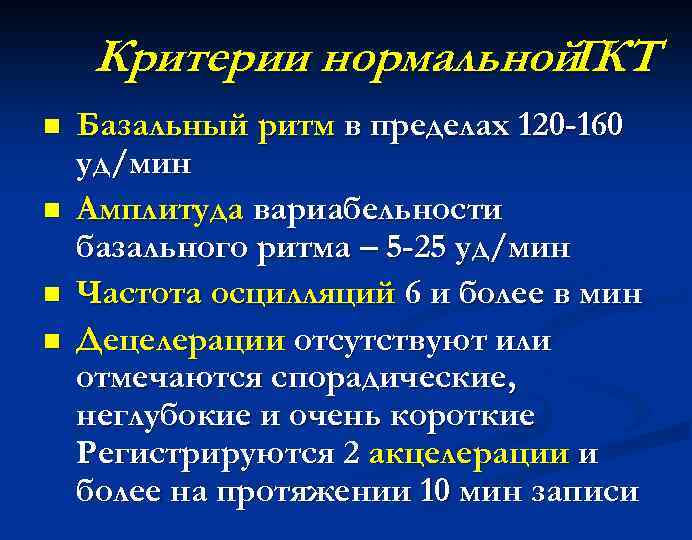 Normal criteria. GCT n n Basal rhythm within 120 -160 beats / min Amplitude of variability of the basal rhythm - 5 -25 beats / min Frequency of oscillations 6 or more per min Decelerations are absent or sporadic, shallow and very short are noted 2 or more accelerations are recorded during 10 minutes of recording
Normal criteria. GCT n n Basal rhythm within 120 -160 beats / min Amplitude of variability of the basal rhythm - 5 -25 beats / min Frequency of oscillations 6 or more per min Decelerations are absent or sporadic, shallow and very short are noted 2 or more accelerations are recorded during 10 minutes of recording
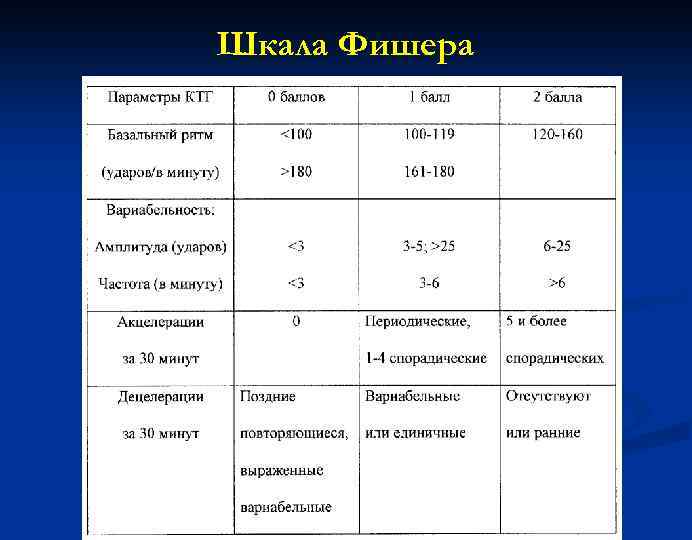
 n n n 8 - 10 points - the norm. 6-7 points - pre-pathological type, re-examination is necessary. Less than 6 points - pathological type, signs of intrauterine fetal hypoxia, requires immediate hospitalization or urgent delivery.
n n n 8 - 10 points - the norm. 6-7 points - pre-pathological type, re-examination is necessary. Less than 6 points - pathological type, signs of intrauterine fetal hypoxia, requires immediate hospitalization or urgent delivery.
 How to have the perfect date when you're not romantic
How to have the perfect date when you're not romantic What diseases do you need to drink coffee - benefits and effects
What diseases do you need to drink coffee - benefits and effects All my brown eyeliners
All my brown eyeliners